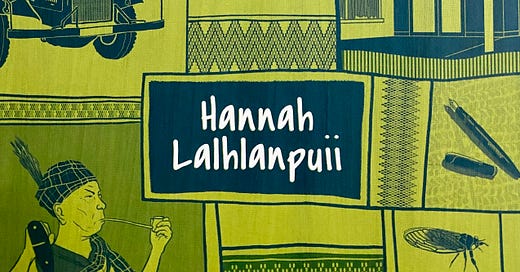“Postcard From The Lushai Brigade” by Hannah Lalhlanpuii. Published by Duckbill. An endearing story of a young boy and his family whose lives get affected by the British presence in the Lushai Hills.
The story is set in Aizawl, the capital of Mizoram and spans across two years from 1942 to 1944. Thirteen year old Bawiha lived with his api (grandmother), mother and elder brother Kima. He was extremely naive and lived in a fantasy world filled with the magic of folk tales narrated by his api. The sorcerer Lalruanga was his favourite and he kept imagining him in different situations. He found joy in the simple things around him. He adored Kima who was an ideal role model according to him. Kima was kind, helpful and could help anyone find a solution to their problems. His mother worked as a housemaid at the bungalow of the British Superintendent Mr McCall.
Mrs McCall was a kind person according to their mother. However api was suspicious and did not shy away from expressing her hatred and distrust for the English people. Their mother continued serving the McCalls unaffected. Bawiha spent his entire day working at the bungalow and playing magic whenever he could. With WWII going on in full swing, Japan was preparing to invade India. The British Indian army was being deployed in the Lushai hills (as Mizoram was called then). The ancestors of the Lushai people were known for their bravery and marksmanship. The British were counting on the tribe being able to stop the Japanese from crossing the Burmese border and entering India. When Kima joins the army, their days of simple joys are over. Read the engrossing book to know how Bawiha faces the changes and what happens next.
The book was a riveting read to say the least. My nine year old and I found it engrossing and couldn’t let go of it. Unlike those from mainland India, the stories of the freedom struggle in the northeast of the country are less known. The British rule caused quite a bit of social and cultural changes for the tribes of the region. The story gives a peek into the Mizo culture, folk tales, the influence of the missionaries and how life must have been under the British rule for the people.
The people got pulled into a war that was not theirs and did not have a choice but to participate. Kima was surprised to see that the Japanese looked so much like them. His realisation that brotherhood is not based on outer looks but in our blood and land has been shown so beautifully. The divide and rule tactic of the British by trying to convince the people that they looked so different from the people of mainland India and they would never be considered one of them lay exposed after this incident. Bawiha’s bonding with Kima, his realisation of why freedom was so desirable, him getting to know about heroes like Saithawma and Queen Ropuiliani from his api and coming to terms with the changes around him are some of the highlights of the story for us.
My son says that his favourite character is Kima for his bravery in choosing to fight a war that he didn’t have to. The book is part of the “Songs of Freedom” series (a favourite at our home) which explores the lives of children across India during the struggle for independence. In all, the book is a “MUST READ”. It helps in bridging the gap in our knowledge and awareness about the northeast of India.
P.S - The other fantastic books from the series that we have read so far are “The Chowpatty Cooking Club”, “That Year at Manikoil”, “The Train to Tanjore”, “A Conspiracy in Calcutta” and “The Letter to Lahore”. A couple of other books on Mizoram that we have read before are “Walking in the Wild” and “When Blackbirds Fly”.
Recommended Age
The book is apt for children aged 10 and above.





